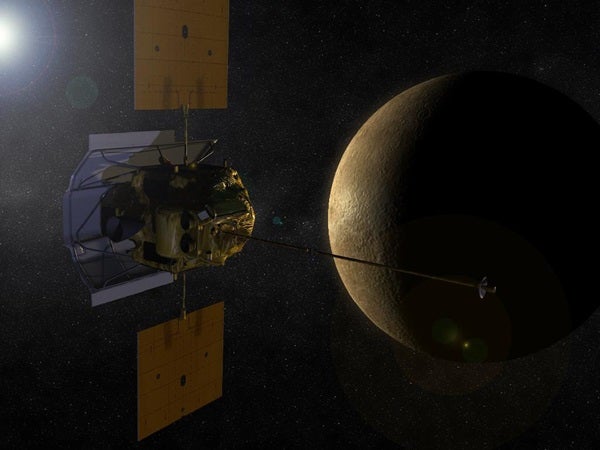“March 17 will be the culmination of decades of aspirations and dreams for the University of Michigan FIPS team,” said Thomas Zurbuchen, from the departments of Atmospheric, Oceanic and Space Science and Aerospace Engineering at the College of Engineering. “FIPS will be the first plasma instrument to explore the plasmas in Mercury’s space environment. This will also be a celebration for the more than 60 students, scientists, engineers, and staff who have collaborated on this project since its beginning in the late nineties.”
MESSENGER was launched in the summer of 2004, with flybys of Venus in 2006 and 2007, and three Mercury flybys between 2008 and 2009. On March 17, 2011, MESSENGER will achieve orbital insertion above the planet closest to the Sun.
Never before have astronomers observed the surface of Mercury in such detail. Of the terrestrial planets in the solar system — including Earth, Venus, and Mars — Mercury is the most unusual and least explored. FIPS will analyze ions and solar winds contained in Mercury’s magnetosphere, the magnetic bubble that protects the planet’s surface, much like the one that shields Earth from solar radiation.
Jim Raines from Michigan Engineering is running the FIPS instrumentation and Bob Lundgren is the lead engineer who deserves much of the credit for building the device. “In today’s NASA, it is very unusual to fly an experiment without heritage,” said Lundgren, “but the scientists knew there would be a significant gap in the mission science without FIPS, so they accepted the risk of developing a new instrument, and Michigan was charged with the task.”
“We have waited a long time — more than 10 years — for this moment to come, and we look forward with great excitement to the discoveries that MESSENGER will make,” said Raines. “With FIPS in particular, we hope to learn a lot about the dynamic, and at times violent space environment of Mercury, including the direct impact of the solar wind plasma on the surface and its interaction with Mercury’s thin atmosphere and magnetic field.”
Video about FIPS:
http://www.youtube.com/watch?v=3vXYLq56seM
“March 17 will be the culmination of decades of aspirations and dreams for the University of Michigan FIPS team,” said Thomas Zurbuchen, from the departments of Atmospheric, Oceanic and Space Science and Aerospace Engineering at the College of Engineering. “FIPS will be the first plasma instrument to explore the plasmas in Mercury’s space environment. This will also be a celebration for the more than 60 students, scientists, engineers, and staff who have collaborated on this project since its beginning in the late nineties.”
MESSENGER was launched in the summer of 2004, with flybys of Venus in 2006 and 2007, and three Mercury flybys between 2008 and 2009. On March 17, 2011, MESSENGER will achieve orbital insertion above the planet closest to the Sun.
Never before have astronomers observed the surface of Mercury in such detail. Of the terrestrial planets in the solar system — including Earth, Venus, and Mars — Mercury is the most unusual and least explored. FIPS will analyze ions and solar winds contained in Mercury’s magnetosphere, the magnetic bubble that protects the planet’s surface, much like the one that shields Earth from solar radiation.
Jim Raines from Michigan Engineering is running the FIPS instrumentation and Bob Lundgren is the lead engineer who deserves much of the credit for building the device. “In today’s NASA, it is very unusual to fly an experiment without heritage,” said Lundgren, “but the scientists knew there would be a significant gap in the mission science without FIPS, so they accepted the risk of developing a new instrument, and Michigan was charged with the task.”
“We have waited a long time — more than 10 years — for this moment to come, and we look forward with great excitement to the discoveries that MESSENGER will make,” said Raines. “With FIPS in particular, we hope to learn a lot about the dynamic, and at times violent space environment of Mercury, including the direct impact of the solar wind plasma on the surface and its interaction with Mercury’s thin atmosphere and magnetic field.”
Video about FIPS:
http://www.youtube.com/watch?v=3vXYLq56seM










